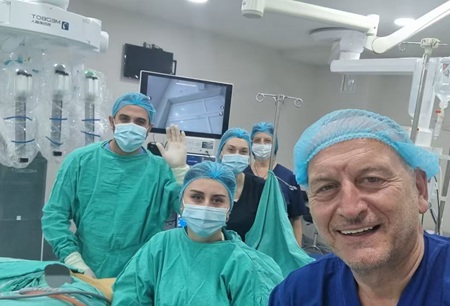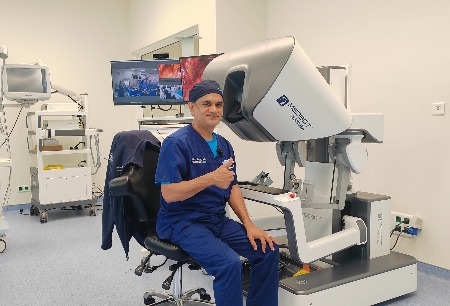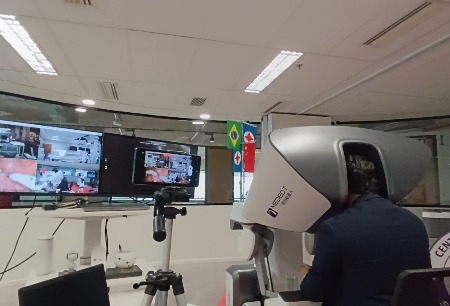Editor's Note:
After rigorous and sufficient technical justifications, animal experiments and scientific ethics evaluations, MicroPort® MedBot® cooperates with many well-known hospitals in China to perform a series of robot-assisted 5G ultra remote surgeries in the fields of urology, hepatobiliary and pancreatic surgery, gastrointestinal surgery, gynecology and obstetrics, chest, orthopedics etc., with an aim to benefit more patients by promoting down-spreading of high-quality medical resources. Recently, Prof. Keqin Hua from the Obstetrics & Gynecology Hospital of Fudan University led his team to complete the first 5G + AI ultra remote China-made robot assisted minimally invasive surgery in Shanghai or even Eastern China, with the assistance from Toumai® Robot. Here is the detailed report from The Paper.
Shanghai, China - On July 25 at Yangpu Campus of the Obstetrics & Gynecology Hospital of Fudan University, Prof. Keqin Hua staring at the screen and skillfully operating the robot console from the hospital’s 5G+AI ultra remote precision gynecological robot surgery command center.
As the leader in minimally invasive gynecological technology in China, Prof. Hua was at that time leading his team members to perform surgery on a female patient who suffered from multiple uterine fibroids and anemia, while this patient was located 2000 kilometers away in Ningxia province. About 2 hours later, this first 5G+AI ultra remote China-made robot-assisted minimally invasive surgery in Shanghai was completed successfully. It is worth mentioning that this surgery is also the first China-made robot-assisted 5G+AI ultra remote gynecological laparoscopy in East China.
As per the hospital, this patient, Aunt Wang, is 50-year-old this year. 8 years ago, she was diagnosed with hysteromyoma during physical examination. But at that time, she felt no discomfort, and thus give no attention to the condition. 6 months ago, Aunt Wang's menstrual period began to lengthen and her menstrual volume gradually increased, and she even presented intermittently experiencing symptoms of dizziness and blackness.
In July 2023, Aunt Wang visited local hospital. After a series of examinations, it was found that her hysteromyoma multiplied, distributed under the uterine mucosa, serosa, and between the muscle walls. Also, her uterus grew to as big as that of 10 gestational weeks. Aunt Wang was diagnosed as multiple hysteromyoma accompanied by anemia, requiring total hysterectomy.
Knowing that Shanghai and Ningxia have maintained nearly 10 years of healthcare cooperation, Aunt Wang was hoping that she could get minimally invasive procedure from Shanghai experts. On the other hand, local physicians were also hoping to receive face-to-face guidance from Shanghai experts, especially in the key stages of surgery.
This surgery was performed under laparoscopy, which required only a few holes of approximately 0.5-1 cm diameters to be made in the patient's belly. However, in this ultra remote surgery, there would be giant data transmission between the two places. So how to ensure that the video connection and the surgical process in both places were synchronized without delay, and critical steps were performed correctly?
The hospital told us that the “Toumai” laparoscopic surgical robot operated by Prof. Hua and his team was developed by Shanghai MicroPort, where Prof. Hua and his team were involved in the whole R&D process.
“This is the first four-arm laparoscopic robot implementing ultra remote surgery by adopting 5G + AI technology in China. It is self-developed and self-produced, and the 5G + AI technology also ensures real-time, accurate, and high-speed long-distance data collection and transmission.” Keqin Hua said. With HD FOV, the command receiving robotic arm transmits data in real-time to patient thousands of miles away, from the moment the robot platform starts operating, and various surgical operations such as dissection, separation, cutting, and suturing will be completed precisely and flexibly. “There is almost no delay in the entire surgical process.”
During surgery, doctors Keqin Hua, Xuyin Zhang, and Junjun Qiu who were located in Shanghai surgery command center made real-time communications with doctors Yan Ding, Shen Sun and supervisor nurse Wenjing Gu, as well as with many healthcare staff from local hospital, through “Zero Stuck” remote connection. They made real-time plan discussion and device adjustments, making the entire surgical process efficient, smooth, and accurate, achieving almost bloodless surgery.
Hua Jiang, president of the Obstetrics & Gynecology Hospital of Fudan University, said that during the construction of a regional medical center, the hospital has been committed to information construction and the application of 5G and AI technology. After the opening of the first 5G one-stop birth defect prevention and control platform in China, the 5G+AI services have been upgraded again, successfully achieving a breakthrough in high challenging gynecological surgery at different places, which is another successful attempt of the hospital on the road of intelligence.
“Our hospital will take this remote surgery as a new starting point, to continuously innovate and develop technological achievements, expanding the application boundaries of remote diagnosis and treatment, solving the contradiction of imbalanced medical resources in the eastern and western regions, breaking the time and space constraints of resource allocation, saving medical and patient time, reducing economic costs, and improving the local medical service level.” Hua Jiang said.
-
 2024-11-18Karazanashvili Robotic Center Completed 100 Toumai® Robot-Assisted Surgeries, becoming the Only Robotic Surgery Center in the Caucasus Region
2024-11-18Karazanashvili Robotic Center Completed 100 Toumai® Robot-Assisted Surgeries, becoming the Only Robotic Surgery Center in the Caucasus Region -
 2024-10-26TOUMAI® SURGICAL ROBOT SYSTEM COMPLETES MULTIPLE LANDMARK ROBOTIC TELESURGERY CASES IN SUB-SAHARA AFRICA IN THE REPUBLIC OF ANGOLA
2024-10-26TOUMAI® SURGICAL ROBOT SYSTEM COMPLETES MULTIPLE LANDMARK ROBOTIC TELESURGERY CASES IN SUB-SAHARA AFRICA IN THE REPUBLIC OF ANGOLA -
 2024-10-26Toumai® Achieves South America's First Tele-Surgery Demonstration
2024-10-26Toumai® Achieves South America's First Tele-Surgery Demonstration






 Hu ICP Bei No. 20013662 HGWA Bei No. 31011502015178
Hu ICP Bei No. 20013662 HGWA Bei No. 31011502015178 " are registered trademarks of Shanghai MicroPort Medical (Group) Co., Ltd.” . They have been authorized to be used by Shanghai Microport Medbot (Group) Co., Ltd., and no other party shall use such trademarks without prior written permission thereof.
" are registered trademarks of Shanghai MicroPort Medical (Group) Co., Ltd.” . They have been authorized to be used by Shanghai Microport Medbot (Group) Co., Ltd., and no other party shall use such trademarks without prior written permission thereof.
